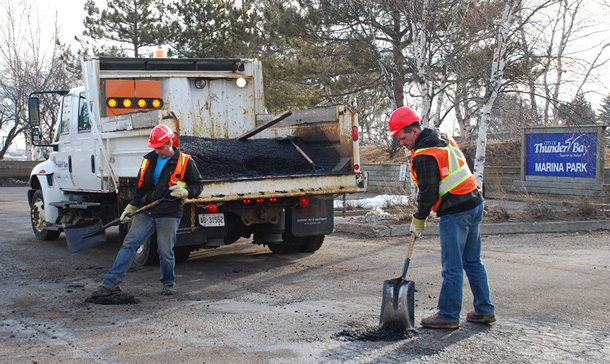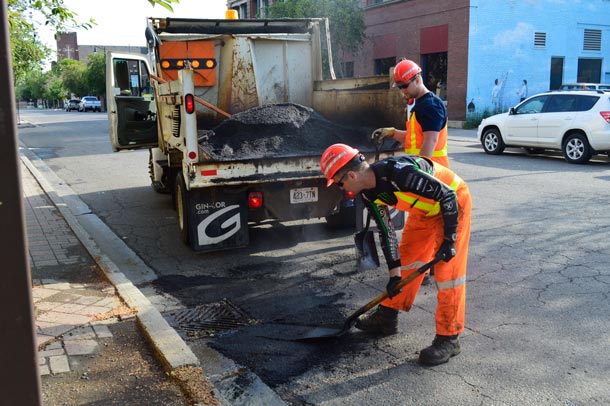
THUNDER BAY – Spring is here. That means the start of construction season in Thunder Bay. It also means the start of the annual ritual of filling potholes across city roads.
The City of Thunder Bay has an online pothole reporting tool, enabling citizens to provide valuable information to City work crews via their computers.
Potholes worsen quickly without prompt action, so timely reporting reduces the expense of road maintenance. March weather conditions favour the development of potholes, which form when the freeze/thaw cycle of seeping water creates voids under the road surface, leading to crumbling pavement and the eventual formation of a hole. Maintenance crews are constantly on the lookout for potholes, but the City welcomes citizen input as well.
If the pothole is on a city street, the Roads Division wants to hear from you. The new online pothole reporting tool allows citizens to input the location of both potholes and raised manhole covers. A photo can also be included in the report. The easy to use reporting tool can be accessed on the City’s website at www.thunderbay.ca/pothole. As always, the Roads Division also welcomes input regarding needed road repairs at publicworks@thunderbay.ca, or at 625-2195 (24 hours a day).
The other issue of course as construction season gets rolling is keeping abreast of road closures, detours and upcoming construction delays.
For Thunder Bay, there is regular reporting on traffic closures on Road Updates on NNL.
In Thunder Bay, while traffic delays can cause frustration, the issue in our small city is far less than in major centres, like Toronto.
In Toronto, co-ordination of construction helping to keep Toronto’s traffic moving Traffic delays tend to give many motorists – and members of the general public – the impression that the City is not co-ordinating its construction projects that affect roads. In fact, the City has a robust planning and co-ordination process.
All projects are reviewed before any work takes place. Factors such as the shortened construction season, work by outside agencies, the high overall volume of the work and the large number of vehicles on the roads all play parts in road congestion.
Drivers who are delayed by traffic backups are understandably frustrated by the unprecedented amount of construction on Toronto’s roads. But the work is critical because the City is updating a significant amount of the aging infrastructure, including roads, bridges, watermains and streetcar tracks. Much of the infrastructure is reaching the end its service life and simply needs to be replaced. Road surfaces also wear out over time and need to be replaced. In addition, the creation of new mass transit infrastructure is affecting roads such as Eglinton Avenue outside the city’s downtown area.
The municipality is not the only organization performing construction work in Toronto. Private companies are busy, too. The city’s significant growth – especially in the downtown core at present – has led to a demand for increased services. More private development brings a need for hard services, such as water and sewer systems, that need to go under the roads.
It does not end there. Organizations such as Enbridge, Toronto Hydro and various telecommunications companies continue to add to their infrastructure. Since most of their infrastructure is buried under the roads, they need to cut into the roads to do their work, often resulting in lane closures and more pressure on adjacent routes.
The pressure on Toronto’s road capacity is clearly intense – but minimizing disruptions to the public is a high priority for the municipal government.
Five years ago, the City of Toronto established a unit called Major Capital Infrastructure Co-ordination (MCIC), which acts as a co-ordinating body for all groups – not just city agencies – that perform construction work in the city. By connecting all the groups, MCIC can make sure long-term work is co-ordinated and that all agencies make the effort needed to bundle their work together – avoiding the need to tear up a road more than once.
The co-ordination does not end there. Because of the high volume of work and unforeseen circumstances that can arise, further co-ordination is required when work is actually ready to take place.
For example, if the sudden appearance of a sinkhole in a road running parallel to a street where road reconstruction is scheduled to take place, City staff would make sure work on the two roads was not done at the same time.
The City also looks at other ways to keep traffic moving effectively while construction occurs. One way is to accelerate the timing of projects when possible. Another strategy involves changes to traffic-signal timing. Another one involves postponing or modifying short-term, non-urgent work on any roads close to a major project that affects traffic.
Despite all of these efforts to minimize traffic disruptions, it is impossible to plan ahead for work required in response to a sudden emergency. Sometimes, an accident or a safety issue will result in a lane of traffic being closed temporarily.
Clearly, Toronto faces challenges in getting critical work done while accommodating all interests in using roadways, and some delays are bound to occur. The City of Toronto, however, is addressing these challenges through project co-ordination and other practical measures as it enhances infrastructure and maintains/improves local roads.







